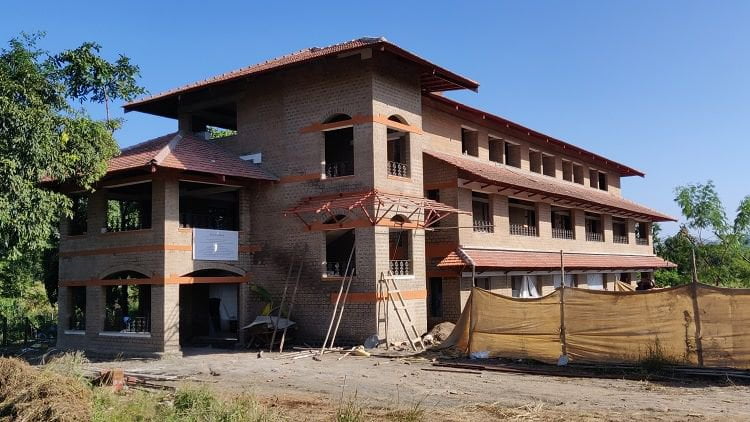Govardhana Eco Village Creates Green Guest Buildings Using Mud Block System
By Madhava Smullen | Ноя 27, 2021

Govardhan Eco Village (GEV), ISKCON’s 100-acre farm in the foothills of the Sahyadri mountain range in Maharashtra, recently completed the final fourteen rooms for its 42-room Mahavan guest building using energy-efficient mud block building technologies.
The same techniques are also currently being used to build the 9,000 square foot Bhajan Ashram, a retreat facility for senior brahmacharis and sannyasis, which will be completed by the end of the year.
The Eco Village will then feature 289,600 sq ft of mud block green buildings, including all its guest accommodation, its goshala for cow protection, its staff quarters, and its Sri Sri Radha Vrindavan Bihari temple.

Govardhana Eco Village Director Gauranga Das demonstrates the manual mud block compressor to visitors
Learning from experts in Bangalore such as Professor Yogananda from the Indian Institute of Science, who introduced the green building technique using Compressed Stabilized Earth Blocks, GEV began building with mud blocks in early 2010.
Since then, it has received many awards for green building, including the Green Village Platinum Ratings from the Indian Green Building Council (IGBC) in 2017, the GRIHA Exemplary Performance Award 2020 for Green Buildings and Habitat, and the United Nations World Tourism Organization (UNWTO) Award for its innovative Eco-Tourism projects as a Catalyst for Rural Development.
It was also the Global Winner for Decarbonising Travel & Tourism at the WTM Responsible Tourism Awards in 2021 and has received accreditation to U.N. bodies such as UN ECOSOC, UNEP, CBS, and UNCCD.

Mud block construction in Govardhan Eco Village
In the process of making its mud block buildings, GEV has trained people from twenty-five tribal villages in Palghar district in this unique system, thus giving villagers who were living below the poverty line a good livelihood. So far, these trained villagers, some now running their own contracting businesses, have built over forty green buildings outside GEV and are continuing to receive more orders.
What’s more, the mud blocks – or Compressed Stabilized Earth Blocks – are eco-friendly. The red bricks commonly used in building are made by heating clay in kilns, which consumes a lot of wood and creates high CO2 emissions. Mud blocks, however are made by compressing a mixture of mud, stone, dust and lime, using a manually controlled machine. Stabilization is achieved using only 5 to 10% cement, and the bricks are dried in the sun.
Mud blocks are also energy efficient — a typical red brick wall takes 72.3 megajoules of energy per kilogram to make, while a mud block wall takes only 0.275 megajoules of energy.

Mud block walls inside guest accommodation
Looking to the future, all GEV’s construction will be green buildings, using mud blocks and other green technologies.
“Currently the building industry contributes to 22% of carbon dioxide emissions,” explains a Govardhana Eco-Village paper on the subject. “The annual energy consumed in India today is a whopping 250 Cr GJ of energy, which is equivalent to burning 15 Cr tons of coal. This is expected to double by the year 2020. In order to address this serious problem, a new revolution is happening all over the world to provide alternative techniques of construction which are eco-friendly, lead to conservation of natural resources, reduce greenhouse gas emissions and conserve energy in operating the building.”
In using mud block techniques, Govardhana Eco Village is part of that revolution.















